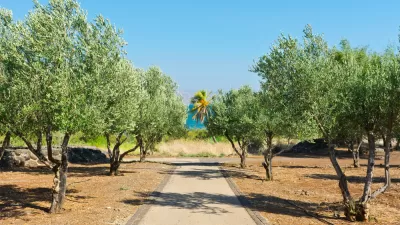This article from GOOD wonders whether farms could become the new cornerstone amenity in suburban residential communities.
The rise of urban agriculture and local farming can be seen in cities across America. GOOD's Allison Arieff looks at how that trend is making its way into the residential developments of suburban U.S.A.
"Look at Google Maps images of any platted but unbuilt or unfinished subdivision-all remaining evidence of what stood before erased, replaced with flattened house lots with nothing on them, paved streets including curvy cul-de-sacs, and even street signs, but no signs of life-and you'll understand the impulse to do things differently. According the American Farmland Trust, more than 6 million acres of agricultural land in the United States were lost to development between 1992 and 1997 alone. Consider that many of those acres were lost to developments that never saw the light of day. Is it too late to restore that acreage? And is it possible that agriculture could be suburbia's best hope?
Well, sort of. It's not as if Orange County, California, despite its dire decline in home values, is going to revert back to acres of orange groves. But around the country, there's a growing interest in looking at the ways agriculture might help retrofit ailing suburbs and cities, and offer an alternative way of thinking about new developments."
FULL STORY: Agriculture is the New Golf: Rethinking Suburban Communities

Alabama: Trump Terminates Settlements for Black Communities Harmed By Raw Sewage
Trump deemed the landmark civil rights agreement “illegal DEI and environmental justice policy.”

Study: Maui’s Plan to Convert Vacation Rentals to Long-Term Housing Could Cause Nearly $1 Billion Economic Loss
The plan would reduce visitor accommodation by 25% resulting in 1,900 jobs lost.

Planetizen Federal Action Tracker
A weekly monitor of how Trump’s orders and actions are impacting planners and planning in America.

Wind Energy on the Rise Despite Federal Policy Reversal
The Trump administration is revoking federal support for renewable energy, but demand for new projects continues unabated.

Passengers Flock to Caltrain After Electrification
The new electric trains are running faster and more reliably, leading to strong ridership growth on the Bay Area rail system.

Texas Churches Rally Behind ‘Yes in God’s Back Yard’ Legislation
Religious leaders want the state to reduce zoning regulations to streamline leasing church-owned land to housing developers.
Urban Design for Planners 1: Software Tools
This six-course series explores essential urban design concepts using open source software and equips planners with the tools they need to participate fully in the urban design process.
Planning for Universal Design
Learn the tools for implementing Universal Design in planning regulations.
Caltrans
Smith Gee Studio
Institute for Housing and Urban Development Studies (IHS)
City of Grandview
Harvard GSD Executive Education
Toledo-Lucas County Plan Commissions
Salt Lake City
NYU Wagner Graduate School of Public Service



























